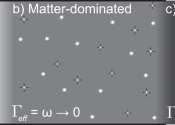Matter is a general term for the substance of which all physical objects consist. Typically, matter includes atoms and other particles which have mass. A common way of defining matter is as anything that has mass and occupies volume. However, different fields use the term in different and sometimes incompatible ways; there is no single agreed scientific meaning of the word "matter".
For much of the history of the natural sciences people have contemplated the exact nature of matter. The idea that matter was built of discrete building blocks, the so-called particulate theory of matter, was first put forward by the Greek philosophers Leucippus (~490 BC) and Democritus (~470–380 BC). Over time an increasingly fine structure for matter was discovered: objects are made from molecules, molecules consist of atoms, which in turn consist of interacting subatomic particles like protons and electrons.
Matter is commonly said to exist in four states (or phases): solid, liquid, gas and plasma. However, advances in experimental techniques have realized other phases, previously only theoretical constructs, such as Bose–Einstein condensates and fermionic condensates. A focus on an elementary-particle view of matter also leads to new phases of matter, such as the quark–gluon plasma.
In physics and chemistry, matter exhibits both wave-like and particle-like properties, the so-called wave–particle duality.
In the realm of cosmology, extensions of the term matter are invoked to include dark matter and dark energy, concepts introduced to explain some odd phenomena of the observable universe, such as the galactic rotation curve. These exotic forms of "matter" do not refer to matter as "building blocks", but rather to currently poorly understood forms of mass and energy.








